Shop our historical maps
History
5 pandemics that claimed the lives of our ancestors

Mar
Many are the plagues, disasters and wars that have swept across Sweden and tested past generations. Here are five of the biggest pandemics to hit Sweden from the 14th century onwards.
I am not writing this article with the intention of scaring anyone during this ongoing pandemic. I am writing it because I think it is important that we remember. Our ancestors have been through a lot of shit. Far more hardship and suffering than we Swedes alive today can imagine.
Remembering our history creates understanding. It's also a constant reminder that sooner or later things always go wrong. A reminder that being prepared for all of life's messes is not optional, but a duty to be taken seriously.
It doesn't matter if it's war, famine, plague or cholera. Sooner or later it happens. Sooner or later the black swan up. Yes, even in small, peaceful Sweden. In the not too distant future, war will also make its return on Swedish soil. Rest assured.
So let us remember, and take with us the realisation that even we who are alive today will have our own messes to get through. Even many of us will lose loved ones in accidents, pandemics and the most unexpected events. Some Swedes, and tens of thousands of Italians, Spaniards, Chinese, Iranians, French, and others, have already lost young and old people they love to a virus from China. If you are one of them, I am sorry for your grief. Know that you are not alone in this ordeal.
It is something that has been tried even by past generations. Here are five pandemics from the 14th century to the present that have reached Sweden.
The Dike Death, 14th century
Dike death, also called black death or the great death, is probably the most famous and also the most deadly pandemic to hit our ancestors. It was the plague, i.e. the bacterium Yersinia pestis, which was the cause and during the dike death all three forms of plague - bubonic plague, pneumonic plague and blood plague
The name "digerdöden" comes from the Old Swedish digher which means 'great', and this name is first recorded on a Gotlandic grave from the 14th or 15th century. Every third person in the whole of Europe died in the Great Death, according to some as many as 60% of the population. Overall, this pandemic is estimated to have resulted in the deaths of 75-200 million people worldwide, at a time when the world's population was 475 million before the outbreak of the plague.
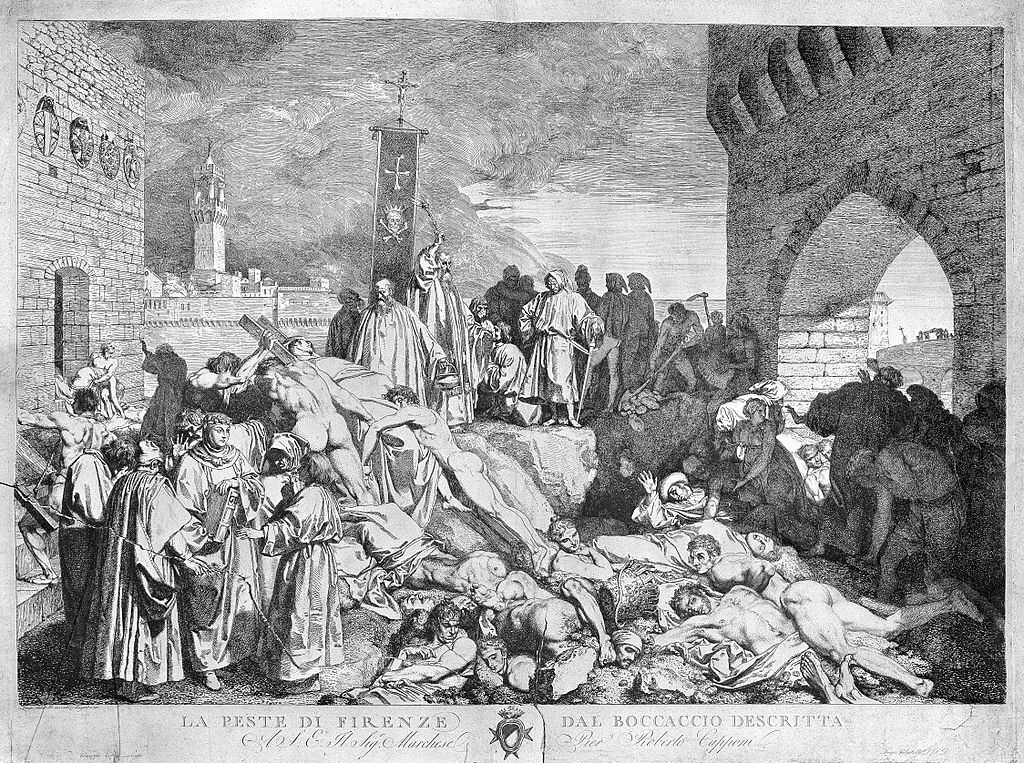
Farms were deserted for generations after the plague passed, and it took 200 years for Europe's population to reach pre-pandemic levels. The plague arrived in Sweden via Norway on a spring day in 1350. Before that, it had travelled all the way from Asia, where it spread along the Silk Road. In 1343, the plague reached Crimea. From there, it was probably spread across the Mediterranean by fleas feeding on the rats that accompanied trading ships, and reached the rest of Europe via Italy.
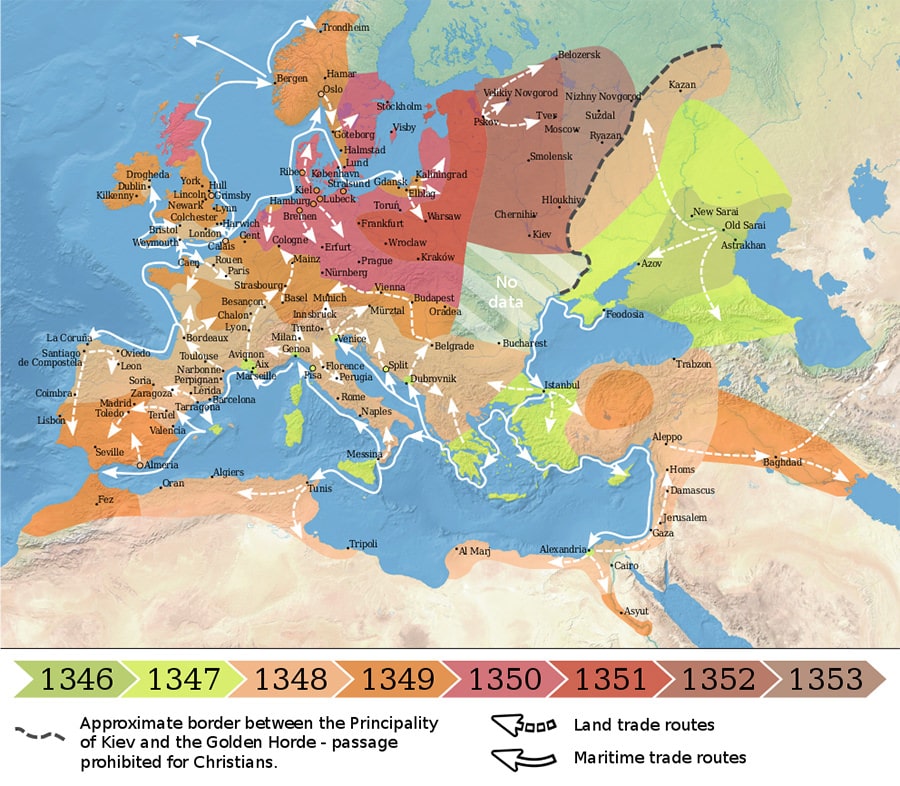
The Plague 1710-1713
The last great plague epidemic struck Sweden from 1710 to 1713 during the Great Northern War which lasted for 21 years between 1700 and 1721. However, this epidemic is considered to belong to the same wave of plague that arrived in Europe in the 14th century and lasted until 1750.
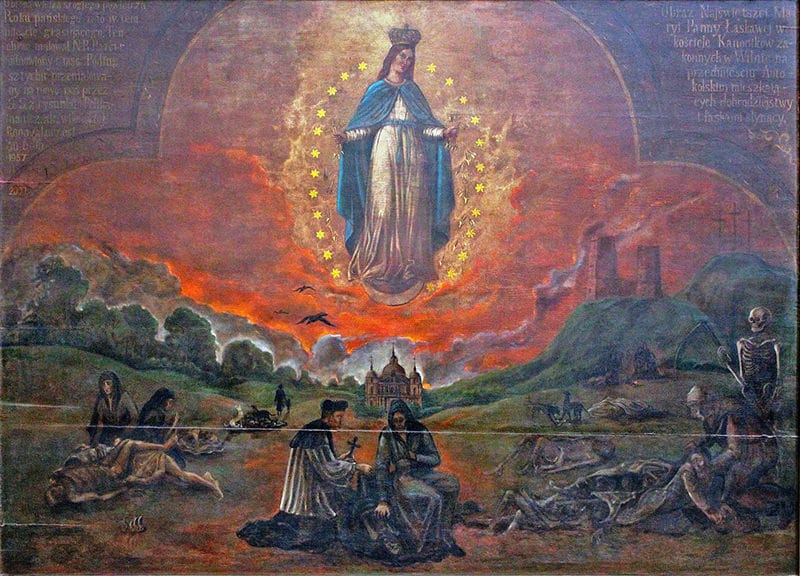
The plague came by boat to Sweden from Livonia and Finland. Originally, the plague came from Asia via Miklagård (better known as Constantinople, or Istanbul, which has been the official name of the city for the Turks since 1926.)
In Uppland and Södermanland the plague raged from July 1710 to February 1711, and the mortality rate was very high. The poor, with their lower and less hygienic standard of living, were the worst affected, often living in close proximity to rats and their fleas. The big cities were hardest hit. In Stockholm, 22,000 of the city's 55,000 inhabitants died, and overall it is estimated that nearly a third of the inhabitants of Stockholm, Gothenburg and Malmö lost their lives to the plague.
Norway took the spread of the disease in Sweden seriously, and issued a royal decree ordering the shooting of any Swede who tried to cross the border. They wanted to prevent the plague from entering Norway at all costs. The corpse was then to be buried "deep in the earth of the same Sted" by overturning it in the grave with long poles to avoid infection themselves. Trade with areas where the plague was present was also forbidden, and pharmacists were ordered to keep large stocks of medicines. This probably contributed to the Norwegians being spared the plague this time.
Norway's action is, moreover, fully in line with Carl Linnaeus' advice on the control of infectious diseases, from July 1773:
At the beginning of infectious diseases, it is most urgent, by prohibitions and other measures, to separate the healthy from the sick, and not to admit to them others than those who can be helped by their care.
Carl von Linné, from a letter from Linné to the Governor's Office in Uppsala, July 1773, on the occasion of the outbreak of dysentery in the city
The Spanish flu, 1918-1921
Spanish disease claimed between 50-100 million lives worldwide in the wake of the First World War. This was at a time when the world's population was 1.6 billion. The Spanish flu thus took more lives than the entire war, 3-6% of the world's population, including 35,000 Swedes. The pandemic broke out in March 1918 and lasted until June 1920, making it the deadliest pandemic of the 20th century. It is also the pandemic that has claimed the most lives in human history in such a short period of time.
Almost all of those who died were under the age of 45, which was characteristic of this pandemic. In normal influenza epidemics, children, the elderly and people with underlying illnesses are the worst affected. Here, young, adult, otherwise healthy people died like flies.
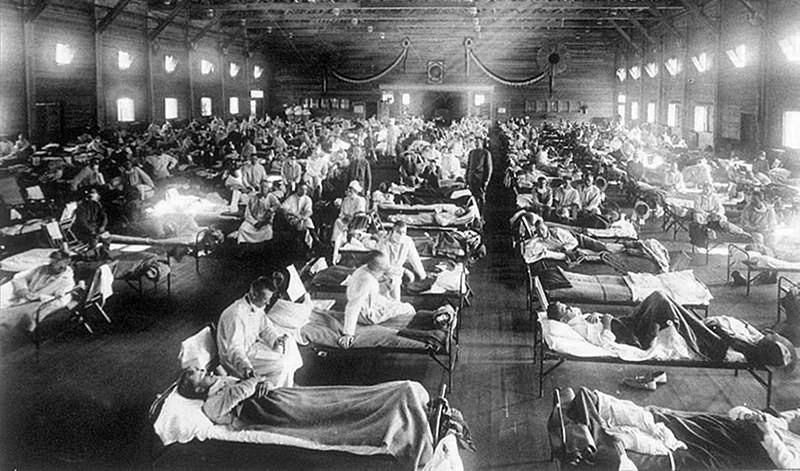
From its name, you might think that the flu originated in Spain, but that's not true. In fact, there has been much uncertainty about its origin. This pandemic broke out during the last years of the First World War, a time when there were very large movements of troops around the world. This is thought to have contributed to the rapid spread of the virus. A theory has since been put forward by experts that Spanish disease originated in northern China and spread rapidly to western Europe with 140,000 Chinese migrant workers recruited by the French and British governments to free up their domestic manpower for the war.
Asians, 1957
The Asian flu was a pandemic caused by the influenza virus A(H2N2), which was identified in Guizhou, China, in early 1956. It spread rapidly throughout the world and reached its peak in Sweden in October 1957, with approximately 312,000 people found to be infected. Current estimates are that 1 million Swedes carried the infection, including Prime Minister Tage Erlander.
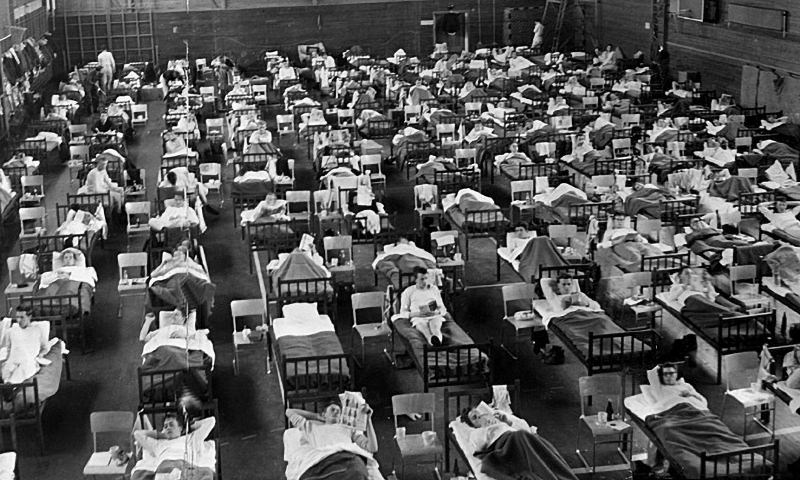
An estimated 5 million people, mostly younger, died from the Asian disease worldwide. In Sweden, however, relatively few people died.
Hong Kong influenza 1968
In the summer of 1968, a pandemic broke out in China and then spread to Hong Kong, where half a million people became ill. It was a new virus, A(H3N2) that was behind the pandemic. It is estimated that the flu claimed about 1 million lives in 1968-1969, mainly the elderly.
Two waves came to Sweden, the first starting in November 1968 and a second, more powerful wave at the turn of 1969-1970. On 27 February 1969, Svenska Dagbladet reports 300,000 cases in Sweden. While the flu was going on, the government was criticised for what it considered to be poor preparedness.
Influenza A(H3N2) is still spread today as seasonal influenza and, according to the National Public Health Agency, causes an excess mortality rate of about 1000 elderly people in Sweden every year1.
He who does not know history is doomed to repeat it
As far back as recorded human history, plagues have haunted us. Even today, the old plague flares up around the globe with 600 new cases annually, mainly in Congo, Madagascar and Peru. Today, plague can be easily treated with antibiotics and prevented from spreading with basic hygiene, but who knows when the plague bacterium will decide to mutate and become antibiotic resistant? New influenza viruses are also appearing all over the world, COVID19 being just the latest. Scientists have declared that it has only been a matter of time before the next global pandemic breaks out.
Why, one might ask, have Swedish politicians and authorities been so slow to react? And why isn't Swedish healthcare better prepared? Why are Swedish health workers now forced to cobble together improvised face shields from office materials? Why have our politicians actively dismantled Swedish total defence? Where are the food stocks? Where are all the stocks of medical supplies? Where are the army's 35 field hospitals that in a short time could relieve Swedish medical care with 10,000 beds and 630 ventilators?
Gone. Puts awake. Equipment that Swedish taxpayers had paid billions for was thrown away in the 1990s, says retired professor Sten Lennquist to DN. Sweden didn't need that anymore, because in little Sweden nothing can happen anyway.
Building preparedness is a choice.
Not building preparedness, to do nothing, to prioritise other things, that is also a choice.
Not carrying your history with you, not thinking about tomorrow, living for the day and spending money on "more fun" things than maintaining preparedness for when life surprises you with a jaw-dropper, that's the easy way out. Until the crisis comes, that is. Walking down that road meant certain death for our ancestors, whose whole life was one long struggle for survival.
But that is the path that Swedish rulers have taken our society down in recent decades. The "just-in-time" society, where the shitty paper can arrive when you've done what you're supposed to do in the toilet and not a second before. It's a choice that in crises costs lives. It is a choice for which Swedish leaders will have to answer.
"Never let a good crisis go to waste"
- Proverbs for Machiavellian politicians
Another lesson we can learn from historical crises is that they, real or staged, are excellent opportunities for those in power to profit financially or politically. When fear and panic spread, public opinion is not infrequently brought to bear to push through the expansion of state powers deemed necessary to meet the crisis, even at the expense of our freedoms. But when the danger is over, they are less willing to give us our freedoms back. So freedom is eroded, bit by bit, crisis by crisis. That is a good thing to know, even during a pandemic.
An observation...
US President Donald Trump has been criticised for referring to the Corona virus on TV as the Chinese the virus. It would be "stigmatizing" or even "racist" to express oneself in such a way. However, one thing I could not help noticing as I researched all these historical pandemics that have hit Europe is that the vast majority have actually been found or are believed to have originated in Asia, mainly China.
Of course, it is not by chance that viruses are repeatedly able to spread to humans in China. It is not a question of bad luck, but of culture. It is about lifestyle and hygiene. I say this without the slightest grudge against the Chinese or their beautiful culture, a culture which, like the Swedish, has roots going back many thousands of years. But it is a pattern that can and indeed should give rise to discussion in more appropriate forums than this site, not least in China, if those in power around the world are serious about reducing the risk of future pandemics.
Sources
- https://www.folkhalsomyndigheten.se/smittskydd-beredskap/krisberedskap/pandemiberedskap/pandemisk-influensa/
Subscribe to YouTube:
If you appreciate Allmogens independent work to portray our fine Swedish history and Nordic culture, you are welcome to buy something nice in the shop or support us with a voluntary donation. Thank you in advance!
Support Allmogens via Swish: 123 258 97 29
Support Allmogens by becoming a member
Support Allmogens in your will

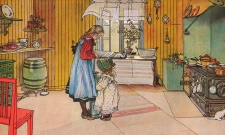







Thanks for this interesting read ! Understand that there is a lot of time and commitment behind getting this down on paper. Have read and taken to me so again warm thanks 🌸
Very interesting reading, scary and our reality today 😢
Which we hope we get out of without losing too many ✊🏼🙏🏼
Fantastically interesting and educational!!! Thank you!!!
"Just-in-time" really relies on you being quick to react. This means that Sweden should have shut down society very early and quickly built up preparedness to then return to normal life. That's pretty much how it worked in South Korea.
Sweden has no "Just-in-time" authorities except "Just-in-time" talk is just talk to justify why it is good to live for the moment. It is the Soviet potemkin backdrop that is what Swedish society is based on today, i.e. pretending that everything is under control when nothing is under control.
You write really well! But to the plague of the war of Charles XII should be added that this man managed to take the lives of nearly 250 000 Swedish conscripted soldiers. To that we must add the lands that could not be farmed because of the lack of hands!
I have sent a link to this to SvD (Gunilla Hall) who claimed that today's pandemic is the worst that has happened in modern times.
A cruel lack of history.
After that, the title was changed to. One of the worst. But that too is unhistorical. And unserious.
I have sent a link to this to SvD (Gunilla Hall) who claimed that today's pandemic is the worst that has happened in modern times.
After that, the headline was changed to: one of the worst.
But that too is unhistorical. And unserious.